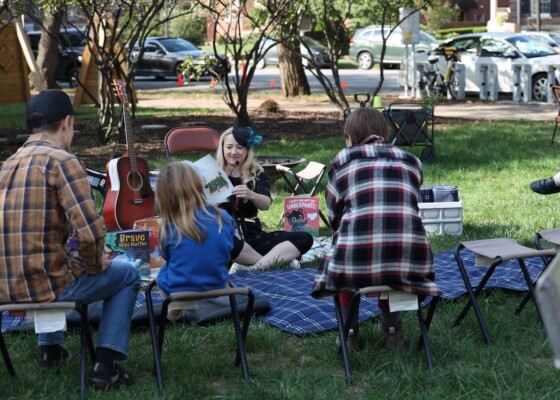Frankenstein Friday: Q&A with John Berners
October 19, 2018As part of One State / One Story: Frankenstein, faculty at the University of Indianapolis developed insightful programs and courses designed to dive deep into Frankenstein in honor of its…
As part of One State / One Story: Frankenstein, faculty at the University of Indianapolis developed insightful programs and courses designed to dive deep into Frankenstein in honor of its 200th anniversary. John Berners, Professor of Music, composed an original score for the first-ever film adaptation of Frankenstein produced by Thomas Edison’s studio in 1910. Read on for Berners’ reflection on the process of creating the score, and then join Berners and other faculty performers on Oct. 26 at 7 p.m. during Indiana Landmarks’ Frightful: Silent Halloween celebration to hear the score for yourself! Get tickets.
Q: What inspired you to choose Edison’s Frankenstein to develop an original score?
Dr. Jennifer Camden of our English Department at UIndy conceived a campus-wide extravaganza of art, plays, films, music etc. related to the bicentennial of Mary Shelley’s novel, Frankenstein. The novel was written in 1816 and published in 1818, so the bicentennial is going on right now. There are Frankenstein festivals in progress across the globe this fall–Halloween 2018 is kind of the climax! At UIndy, the Theatre, Art & Design, Music, English and other departments got involved. Jennifer discovered this classic silent film, which had once been lost for decades (and is now lost again!) A digital copy exists and Dr. Camden asked asked me to re-score the film for live performers. I’d rarely written to picture before, but I loved the idea of doing a film, and it turned out to be very exciting to work on. I liked that it was only 13 minutes long, I could use my own contemporary musical style, and there was no dialogue or sound effects I had to work around!
Dr. Camden offers this background about the film:
Mary Shelley’s novel was adapted for the stage a mere five years after it was published. In a letter written after she attend the play, Shelley quipped: “But lo and behold! I found myself famous!” The first film adaptation of her novel was Edison Studios’ 1910 silent film, which received positive reviews, but was not a box office success. For many years, the film was believed lost: in 1980, the American Film Institute placed it on their list of the top ten most culturally and historically significant lost films. A Wisconsin film collector, Alois F. Dettlaff, discovered an original copy of the 35mm release of the film. Noting the deteriorating condition of the film, Detlaff allowed a digital copy to be made, which is available through Graveyard Records. Dettlaff was very protective of the original copy of the film and refused to disclose its location: at his death, his family were unable to find the original film.
Q: How does your score differ from what was historically heard alongside the film?
In 1910, when the film came out, it was typical for a pianist or organist at the theater to just improvise to the silent picture, creating moods to match the film. Frankenstein was a bit unusual in that the director supplied a scene-by scene cue sheet asking the musicians to play clips of specific classical pieces by Weber, Wagner, etc. to fit the action.
My score is one long piece of music that goes from beginning to end of the movie, following the story closely. Unlike the classical excerpts, it is scored to specifically match the onscreen action, moment to moment. Most movie scores are done this way now, of course. A possible unique feature of my score is that I used a very small ensemble, just two voices and two instruments. Vocal music with text isn’t very common as “underscore” in contemporary movies, since today there is also dialogue – actors are often speaking over the score! But in a silent movie, there is room for singers and text. In my score, singers don’t tell the story or add dialogue. But, they speak and sing in English, French and Latin in an impressionistic way, to support the moods.
Q: How did you decide what the music should sound and feel like?
As I began the project, through reading the novel and watching the film. I soon became sympathetic to the monster! To me, besides all the difficult conflicts and moral dilemmas, it is a tragic tale of alienation and rejection. The film highlights this. Speaking of his 1910 film adaptation, director J. S. Dawley said he meant to “eliminate…repulsive situations and concentrate…upon the mystic and psychological problems.” You’ll notice that unlike Shelley’s monster, Dawley’s never hurts anyone, and the film’s mirror device proposes an unexpected relationship between Frankenstein and the creature. So, in seeking to musically support the moods of the film, I took it not as a horror story, but as a tragedy.
Use of voices and text in the score allow the music to comment on situations in the film. I chose excerpts from the Requiem text which, when sung in Latin, work well for weighty issues of existence and death. Other verses are heard in the characters’ native French, which gives a lighter lyrical quality.
The musical style of my score is of our time, not the musical period of the film. My feeling was that this elegantly simple film, with its universal themes that seem to become only more relevant with time, could mesh well with current music.
Latin Requiem and other texts and translations used in the film score:
Domine Jesu
de morte transire ad vitam passer de la mort à la vie to pass from death to life
De Profundis (psalm 129)
De profúndis clamávi ad te Du fond de l’abîme je t’invoque Out of the depths I cry to you
Libera me
Trémens fáctus sum égo, et tímeo, I am seized with fear and trembling,
dum discussio vénerit, awaiting the day of trial,
atque ventúra íra. and the wrath to come
Quando caéli movéndi sunt et térra. when the heavens and Earth shall be moved.
Dies Irae
Dies írae, díes ílla Jour de colère, ce jour-là Day of wrath, that day
Sólvet saéclum in favílla Qua réduira le monde en cendres shall consume the world in ashes
Sequence 1.
Quid sum míser tunc dictúrus? Que dirai-je alors malheureux? What shall I, a wretch, say then?
Quem patrónum rogatúrus? A quel avocat recourir? To which protector shall I appeal?
Q: What do you believe a live score adds to a silent film?
The live element adds immediacy, especially in a movie over 100 years old, which would be easy to feel distant from. However, the situations and conflicts in Frankenstein are quite modern—technology run amok, blurring the boundaries of human/non-human–so if we give the actors and story a chance, it can be involving. The contemporary live music helps make that connection.


